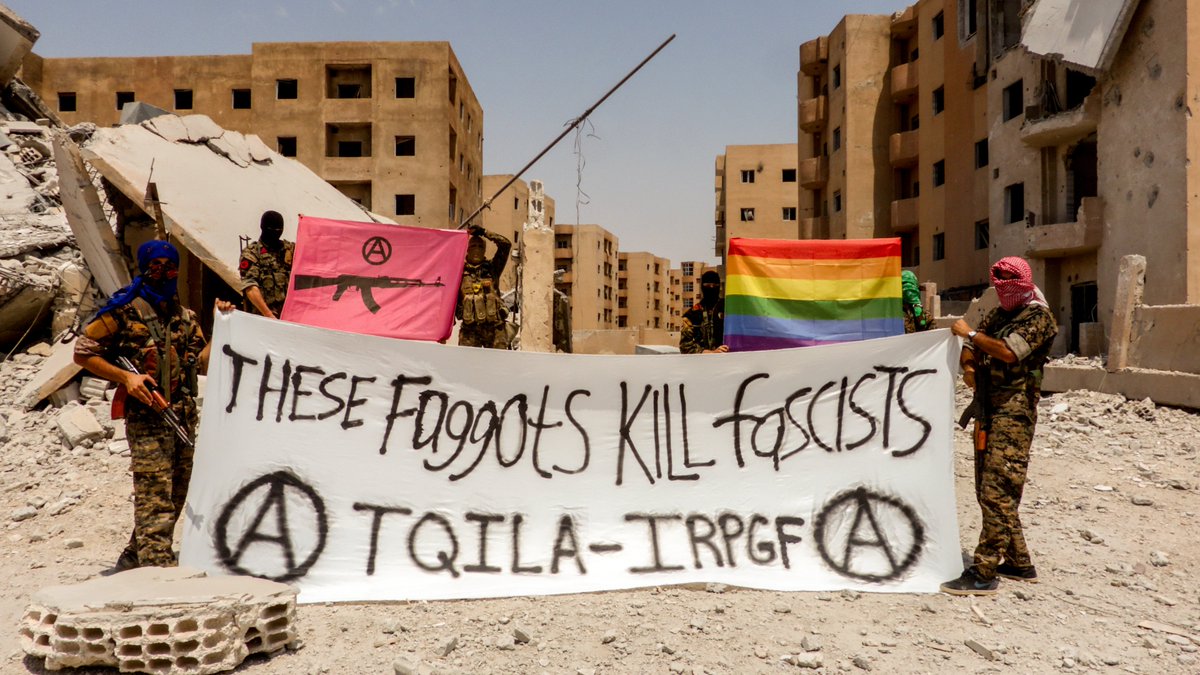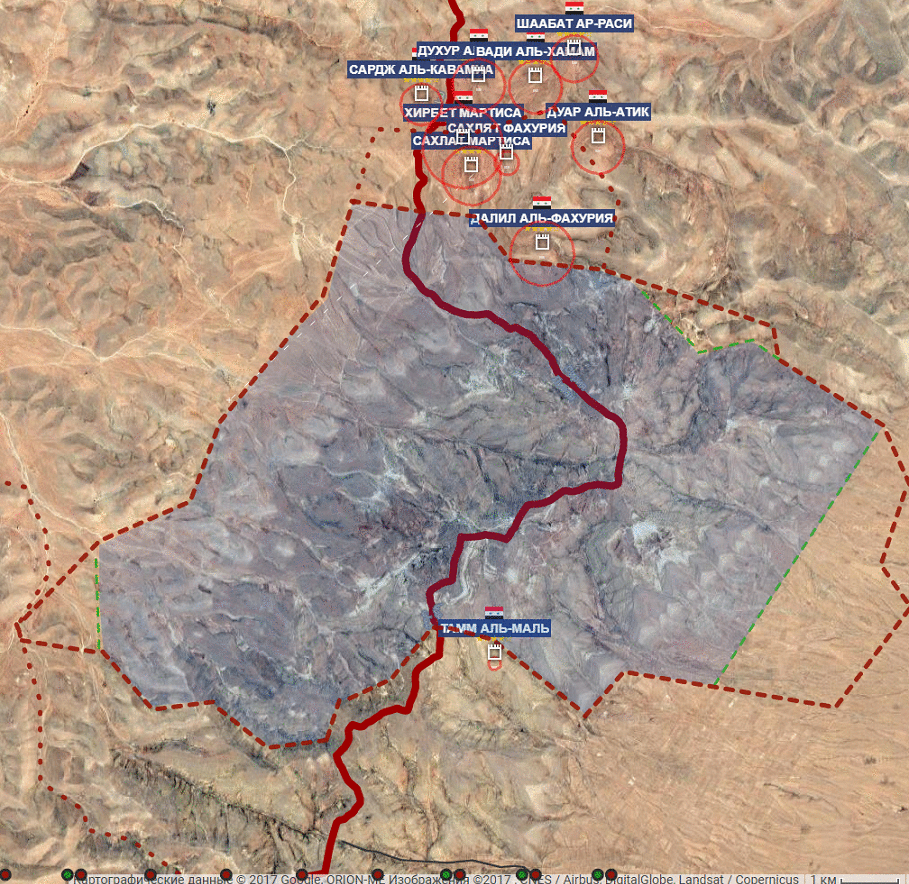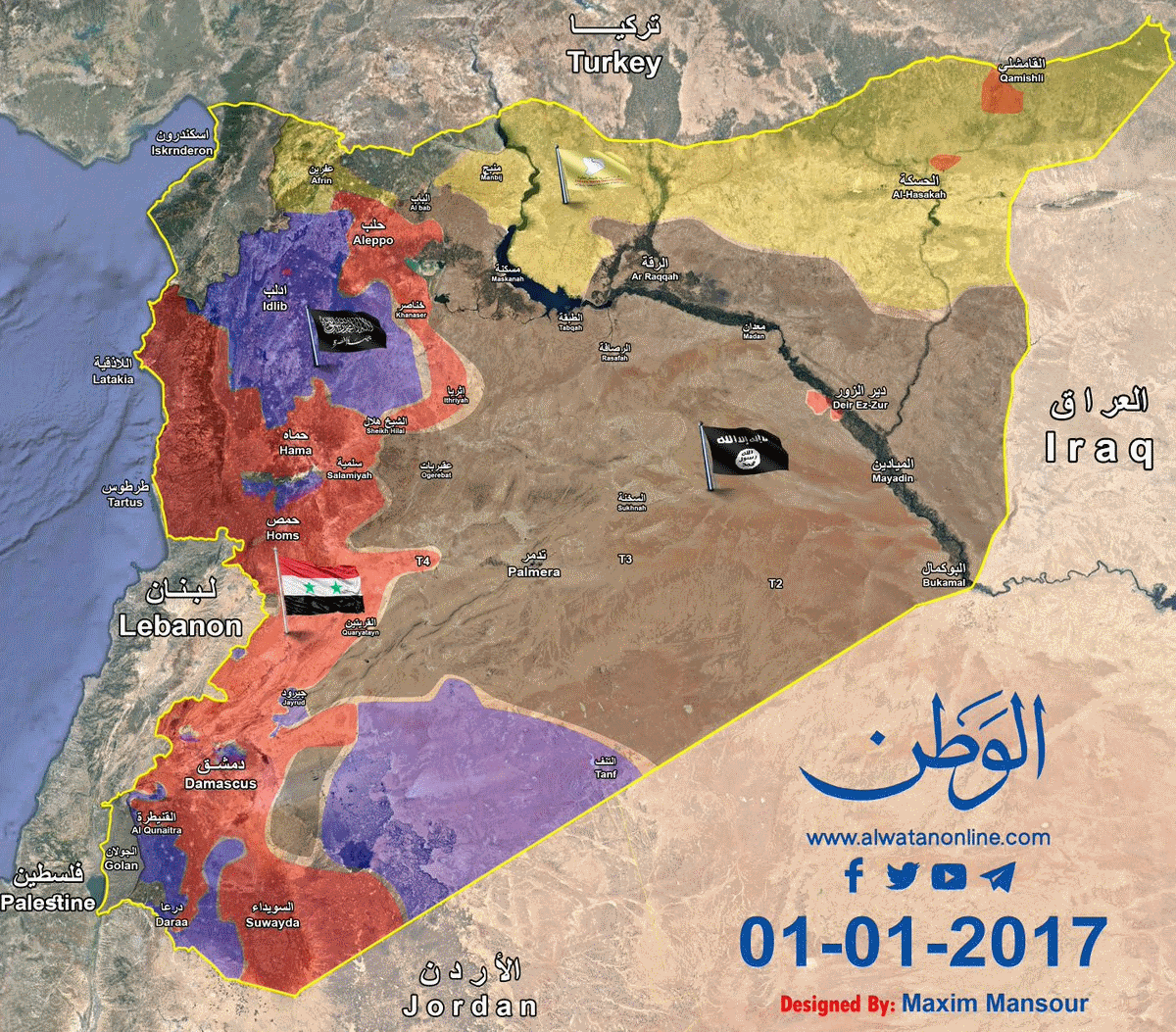Войната в Сирия - том 2 - 2017
Отиди на страница:


| СМ: курдские бойцы приостановили штурм Ракки из-за угрозы турецкого вторжения Отряды вооруженной коалиции "Силы демократической Сирии" (СДС) снизили темп операции по освобождению города Ракка (520 км от Дамаска) от террористов. Как сообщила в понедельник газета Al Watan, боевые действия приняли там позиционный характер после успешного штурма 5 июля старинной цитадели, где находится основной форпост экстремистской группировки "Исламское государство" (ИГ, запрещена в РФ). Перестрелки идут сейчас на линии соприкосновения в районе улиц 23 февраля, Абуль-Хейс и Сейф-эд-Давля. По сведениям издания, командиры курдских отрядов, которые составляют костяк СДС, пошли преднамеренно на такой тактический шаг из-за угрозы вторжения турецких войск в кантон Африн в 60 км к западу от Алеппо, где проживает около 1 млн курдов. Как пишет издание, курды дожидаются, когда Вашингтон окажет давление на Анкару и объявит свое вето на новую турецкую интервенцию на севере Сирии. Газета утверждает, что турецкая артиллерия и танки вторые сутки ведут непрерывный огонь по позициям курдских сил самообороны в Африне. В рядах ополченцев растут потери. Натисни тук |
| Кинули??? Натисни тук http://www.lapresse.ca/international/dossiers/crise-dans-le-monde-arabe/guerre-civile-en-syrie/201707/19/01-5117593-la-cia-met-fin-au-soutien-aux-rebelles-syriens.php Оригиналната статия във "Вашингтон Пост" иска да си разблокирам блокировката на рекламите, затова си я чета на френски. Бърза извадка: "ЦРУ реши да прекрати програмата си за подкрепа за сирийските бунтовници, борещи се срещу сирийския президент Башар Асад, се казва в Washington Post.Тази програма за подкрепа инициирана преди четири години е имала ограничено въздействие, особено след присъединяването на руските въоръжени сили към Башар Асад през 2015 г., са признали пред ежеднедника американски представители при условие за анонимност. Президентът Доналд Тръмп е взел решението преди почти месец след среща с шефа на ЦРУ, Майк Помпео и съветника за националната сигурност генерал Х. Р. Макмастър, се казва в Washington Post." |
| "Хизбалла" сообщила о ликвидации десятков джихадистов время публикации: 23 июля 2017 г., 13:21 | последнее обновление: 23 июля 2017 г., 13:21 блог версия для печати фото "Хизбалла" сообщила о ликвидации десятков джихадистов Группировка "Хизбалла" сообщает о значительных успехах, достигнутых в боях с джихадистами "Исламского государства" и "Джабхат Фаттах аш-Шам" в районе города Арсаль на северо-востоке Ливана. Как утверждается, шиитские боевики контролируют около 64% района. За последние три дня 46 боевика "Джабхат Фаттах аш-Шам" погибли в районе Арсаля и еще 23 – в горном районе Каламун на сирийской стороне границы. Командование ливанской армии сообщило, что бывший заместитель мэра Арсаля Ахмад аль-Флити, посланный в качестве парламентера к джихидистам "Джабхат Фаттах аш-Шам", был ими убит. Наступление на позиции джихадистов ведется с обеих сторон границы, при этом сирийская армия на ливанскую территорию не заходит. Как отмечается, операция не ограничена во времени и будет продолжаться до достижения целей. В этом районе расположено множество лагерей сирийских беженцев. Местные активисты заявляют, что армия и шиитские боевики проводят зачистки именно в них, избегая вступать в бой с ИГ и "Джабхат Фаттах аш-Шам" *** ВВС Сирии нарушили перемирие в районе Дамаска время публикации: 23 июля 2017 г., 12:02 | последнее обновление: 23 июля 2017 г., 12:05 блог версия для печати фото ВВС Сирии нарушили перемирие в районе Дамаска 23 июля сирийские ВВС нанесли по меньшей мере шесть авиаударов по расположенному в окрестностях Дамаска району Восточная Гута. В этом районе действует соглашение о прекращении огня. Согласно сирийской оппозиции, особо мощный удар нанесен по деревне Айн Тарма. Здесь действует и артиллерия, а боях участвуют танки и тяжелая инженерная техника, в том числе – бульдозеры. Наступление на населенный пункт ведут две бригады Республиканской гвардии. С начала июля этим частям удалось освободить от оппозиционных ополченцев южную часть Айн Тармы. Сейчас они медленно продвигаются к центру. Деревню отстаивают боевики входящей в состав Армии свободной Сирии бригады "Файлак аль-Рахман" и местного отделения «Аль-Каиды» - группировки "Хайрат Тахрир аш-Шам". |
| Secret Russian-Kurdish-Syrian military cooperation is happening in Syria’s eastern desert In the first of a series from Syria, Robert Fisk says that new connections, however tenuous, demonstrate that all sides are determined to avoid military confrontation between Moscow and Washington http://www.independent.co.uk/voices/syria-isis-russia-kurdish-ypg-happening-in-secret-a7857471.html |
Туй вече ме срази! https://twitter.com/IRPGF/status/889445690656608256 |
| Натисни тук Washington's Dead End in Syria - Victory Will Only Last if the U.S. Stays By Sam Heller On July 4, the Kurdish-dominated Syrian Democratic Forces (SDF), backed by the U.S.-led coalition against the Islamic State (also known as ISIS), broke into the Old City of Raqqa, the jihadist pseudo-state’s de facto Syrian capital. Although fighting in Raqqa will continue to be a bloody grind, when it is over, the battle will be the capstone of what is now a successful, years-long collaboration between the U.S.-led coalition and the SDF. But the battle against ISIS will not end with the liberation of Raqqa, and neither will the United States’ commitments in Syria. Washington’s approach to fighting ISIS in Syria—and in particular the local Kurdish partner it has chosen—has granted a victory that can last only as long as the United States stays. If one looks beyond Raqqa and the immediate campaign against ISIS, the bigger strategic picture is alarming: the United States has set itself up for an indefinite presence in northeast Syria, in the middle of an unsettled and unfriendly region, with no obvious way to leave. DIFFICULT ALLIES The SDF is a Syrian force led by the Kurdish People’s Protection Units (YPG), with which the coalition struck up a tactical partnership against ISIS in 2014. In 2015, the U.S. military helped rebrand the YPG and its smaller, subordinate allies as the “SDF,” apparently in order to put the group in a slightly less controversial package. The YPG is closely linked to the Kurdistan Workers’ Party (PKK), which has waged a decades-long insurgency in neighboring Turkey, Washington’s NATO ally. Further, the YPG and its civilian parallel, the Democratic Union Party (PYD), are seeded throughout with PKK-trained cadres. This has not been lost on Turkey, which sees the PYD-YPG as the PKK’s Syrian affiliate. Since 2014, Ankara has watched the group’s territorial and numerical expansion with alarm, even as it has grappled with a revived PKK insurgency inside Turkey. The United States has set itself up for an indefinite presence in northeast Syria. The Obama administration, in a sop to Turkey, insisted it was supplying only the SDF’s uncontroversial Arab elements with weapons. Turkey was not satisfied—both U.S. and Turkish officials understood that these Arab units functioned as auxiliaries to the SDF’s YPG core. Then in May, the Trump administration announced that it would arm the YPG directly in its fight for Raqqa. Washington’s partnership with the YPG has been a functional one: the United States is in Syria to kill ISIS, and the YPG is excellent at killing ISIS. It is a motivated, coherent, and reliable military force. The alternatives, including those pitched by Turkey in the lead-up to the battle for Raqqa, were not. But there is little clarity about what the United States will do when the killing is done and what will happen to its partnership with the YPG. During a panel on U.S.-Turkish relations in May, State Department official Jonathan Cohen described Washington’s relationship with the YPG as “temporary, transactional, [and] tactical.” In June, State Department spokesperson Heather Nauert was noncommittal, saying that the United States saw the SDF as the “best force to take back control over Raqqa” while declining to “characterize or get into hypotheticals about the future.” Secretary of Defense Jim Mattis has given mixed signals about whether the United States will continue to arm the YPG after Raqqa. So far, the United States has made a limited investment in stabilization programming in areas retaken from ISIS by the SDF. Yet U.S. officials have also been emphatic that they will not invest in large-scale reconstruction or nation building—not without a credible political settlement to Syria’s civil war that would turn the regime of President Bashar al-Assad into an acceptable state partner. A PATH TO PEACE? The United States aims to defeat ISIS, not to foster a PYD political project or to take permanent ownership of part of Syria. Yet Washington seemingly cannot declare victory and leave. If it abruptly concludes the battle against ISIS and withdraws from Syria’s northeast, Turkey will attack—or at least that’s what Turkish officials told me. The resulting maelstrom would do grave damage to both Turkey and the YPG. Such chaos would almost certainly give ISIS a chance to recover and reverse the U.S.-led coalition’s gains. It is possible to imagine an arrangement—a settlement between the Assad regime and the PYD—that could bring the relevant Syrian and regional forces into a rough equilibrium and allow the United States to exit. The PYD, unlike Syria’s revolutionary opposition, has deliberately set its political ambitions below the threshold of regime change. As a result, it and the Assad regime have kept up a tense but functional relationship, and Kurdish and regime-controlled areas have remained institutionally and economically intertwined. In theory, the Assad regime, PYD, and Turkish positions could be roughly harmonized through a PYD-regime agreement that would preserve some local autonomy in Kurdish areas while ensuring Syria’s territorial integrity and reintroducing enough central state sovereignty to assuage Turkey’s fears. Even if Turkey still objected, the deal could place a joint Syrian-Russian force on the border with Turkey, which Turkey would be unwilling to attack. In practice, however, this seems unlikely in the near term. The present PYD-regime détente is a long way from a more substantive, complete agreement. Kurdish officials told me that Russian-sponsored negotiations between the two have gone nowhere. They blamed an Assad regime that, even after six years of war, is still maximalist and unreasonable and refuses to recognize what they see as their “rights.” But the PYD is also unwilling to compromise and seems unlikely to make hard choices as long as it is backstopped by the United States. Inside the U.S. government, moreover, there is little appetite for actively midwifing an agreement between the PYD and Damascus, which is still viewed as toxic and beholden to Iran. In addition, the return of state control to Syria’s northeast would likely be incompatible with the United States’ ongoing counter-ISIS campaign, which would rely on U.S. Special Forces’ freedom to base and operate in the area. And U.S. support for the YPG has helpfully encouraged it to rebuff Iranian overtures, preventing Tehran from establishing a supply route from Iraq to Syria and Lebanon via Syria’s Kurdish northeast. There is little clarity about what the United States will do when the killing is done. But the absence of a deal likely means an open-ended, residual U.S. presence in northeast Syria—a de facto partition that will keep Syria and its neighbors in an indefinite limbo. In this scenario, the United States would become the guarantor of a Syrian-Kurdish half state that disrupts and unbalances everything around it. This state would have minimally functional, U.S.-sponsored institutions and services but too little investment to develop and prosper. It would lack open, functional economic links with its neighbors, including Iraqi Kurdistan. To maintain regional peace, Washington would have to continually appeal to the PKK not to attack Turkey, which would in turn be permanently agitated, even if the United States’ presence dissuaded it from intervening in northeast Syria. Yet as one Turkish official warned me: If and when the PKK or its splinter groups carry out a major attack in Turkey, Turkey will respond by bombing YPG targets inside Syria. And eventually, Ankara seems likely to accidentally injure or kill Americans collocated with the PYD or YPG, threatening the U.S.-Turkish alliance and causing American lives to be lost. A DEAD END At this point, such a partition may be the best outcome available. But by any objective measure, it is not a good one. In partnering with the YPG, the United States has won its way into a strategic dead end. It needs to look for an exit. In particular, it should seriously investigate possible coordination with Russia. Kurdish officials told me that Russia is already attempting to lean on the YPG to allow more of the regime back into a northwestern Kurdish enclave outside the United States’ protective umbrella. In the northeast, Russia may be able to help bring the regime and the YPG to a mutually dissatisfying but useful compromise, for which Russia could serve as guarantor. Winning against ISIS means uprooting the group from its core territory, neutralizing its threat to regional order, disrupting its external operations capability, and then, ideally, leaving in a way that doesn’t explode all of that. Washington needs to start formulating an exit strategy for northeast Syria. Without one, sustaining victory over ISIS may mean pouring U.S. troops, resources, and credibility into a black hole of regional instability, seemingly forever. | |
Редактирано: 1 път. Последна промяна от: проф. дървингов |
| САА трепе идилчовците повсеместно! На ден превземат по 10-тина километра по десния бряг на Ефрат. Така "Тигрите" след ок. седмица ще разблокират Дер-ез Зор от север. Същевременно от запад САА се доближи само на 2 км от ключовия град в пустинята Сухна. Оттам до Дер-ез Зор са 70 км. Върви операцията по вкарването в чувал на цирея Акербат (на северозапад от Палмира). ИДИЛ се пука по шевовете.  Скоро ще започнат следвоенните пазарлъци. |
| Сирийская армия заняла окраины города Дейр-эз-Зор 11 августа 2017, 16:00 Армия Сирийской арабской республики дошла до одного из важнейших городов в зоне боевых действий Дейр-эз-Зора, на окраинах которого ведет ожесточенные бои. Как передает телеканал «Звезда», сирийская армия окружает населенный пункт с разных сторон и постепенно продвигается вглубь города. На кадрах, опубликованных на сайте телеканала, видно, что над позициями ИГ* поднимаются клубы густого дыма, в следствие активного применения армией Сирии гранатометов для подавления противника. Натисни тук |
| https://ria.ru/syria/20170816/1500459285.html Сирия обвини САЩ и Великобритания в доставка на отровни вещества на „опозицията”. Ще налагаме ли санкции, или направо да мятаме томахавки по Вашингтон и Лондон? |
ВКС России уничтожают бегущих из окружения боевиков ИГИЛ — видео После окружения группировки боевиков ИГИЛ* в районе города Акербат террористы лишились последнего маршрута снабжения боеприпасами, оружием и провизией. Окружённые боевики приняли решение прорываться сквозь позиции сирийской армии малыми группами в сторону Дейр-эз-Зора. Однако их прорыв был остановлен благодаря точным авиаударам российских лётчиков. https://life.ru/t/новости/1036336/vks_rossii_unichtozhaiut_bieghushchikh_iz_okruzhieniia_boievikov_ighil_--_vidieo |
| В Ливане у террористов "ан-Нусры"* нашли американские ракеты https://ria.ru/world/20170818/1500667799.html |
Зоны деэскалации конфликта в Сирии  https://ria.ru/infografika/20170713/1498462317.html | |
Редактирано: 1 път. Последна промяна от: Туткалчев |
| Русия пуска "Нощния ловец" Ми-28УБ срещу "Ислямска държава" Наближава краят на войната. Време е за операция "Дойти до Берлина".  https://bg.rbth.com/ruska_armiya/2017/08/20/rusiya-puska-noshchniya-lovec-mi-28ub-sreshchu-islyamska-drzhava_825416 | |
Редактирано: 2 пъти. Последна промяна от: Казуса |
Начальник Главного оперативного управления Генштаба ВС РФ генерал-полковник Сергей Рудской провел брифинг для представителей СМИ Группировка правительственных войск, действующая к востоку от Пальмиры, овладела стратегически важным населенным пунктом Эс-Сухне и без остановок развивает наступление на Дейр-Эз-Зор. Для уничтожения окруженных и пытающихся отойти в направлении Дейр-Эз-Зора террористов интенсивность применения российской авиации увеличена до 60-70 боевых вылетов в сутки. ВКС России в круглосуточном режиме осуществляют воздушную разведку, выявление и уничтожение бронетехники игиловцев, пикапов с тяжелым вооружением и автомобильных колонн с боеприпасами. За последние 5 суток российские самолеты совершили 316 вылетов и нанесли 819 ударов. Всего в августе авиацией ВКС России выполнено 990 боевых вылетов. По командным пунктам, позициям, складам, перевалочным базам и лагерям боевиков нанесено 2518 авиационных ударов. Уничтожено 40 единиц бронетехники, 106 автомобилей с установленными на них крупнокалиберными пулеметами и до 800 террористов. Таким образом, освобождение от террористов центральной части Сирии близится к завершению. http://function.mil.ru/news_page/country/more.htm?id=12139198@egNews Адски любопитно четиво!  |
| Главорезите ядат страшен бой на сирийско-ливанската граница в областта за Западен Каламун. Подпукали са ги от двете страни: от Ливан - Хизбула и редовната ливанска армия, от Сирия - САА. Ето резултатите от последните два дена:  |
| Вижте какво стана със западната част на планината Каламун на сирийско-ливанската граница. Малко по-горе е показано положението на 23 август. А ето как е днес:  | |
Редактирано: 1 път. Последна промяна от: Туткалчев |
| Със змиярника от двете страни на сирийско-ливанската граница в областта на Западен Каламун бе приключено. Със страшна сила се ликвидира змиярникът около градчето Акербат в провинция Хама. Картата на Сирия с разположението на противоборстващите сили вече изглежда така (може да се увеличава): http://imgur.com/i6i81y1 | |
Редактирано: 6 пъти. Последна промяна от: Туткалчев |

